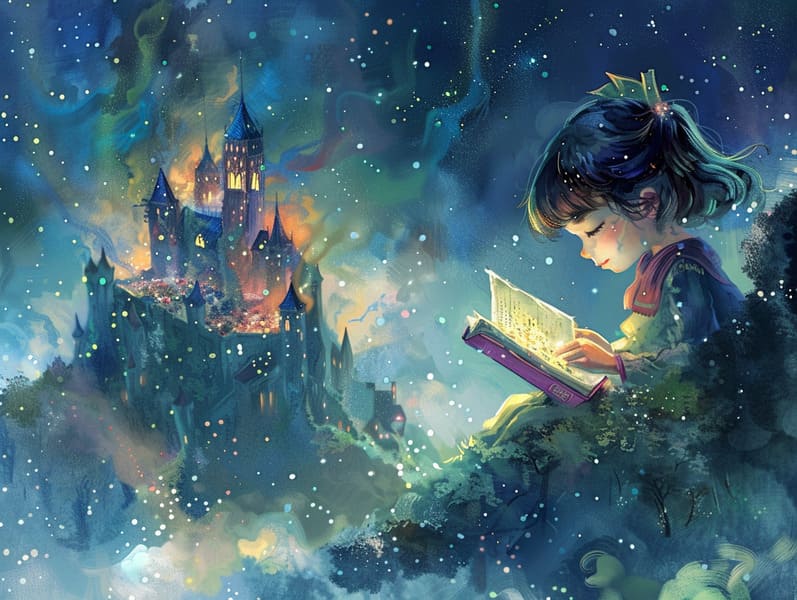
Fairy tales for kids have old origins. These stories have been relayed from one generation to the next long before they were ever put on paper. They developed from a variety of societies, including European traditions. They were initially conveyed among grown-ups, often carrying themes and messages concerning the societal norms and beliefs of the time.
The famous Grimm duo, Jacob and Wilhelm, were among the first to collect many of these beloved narratives. Their published works, "Grimm's Fairy Stories," included stories like "The True Bride," "Little Brother and Little Sister," and "The True Story of Snow White," which have since become cornerstones in the world of children's fairy tales. Similarly, Hans Andersen's fanciful narratives, such as "The Story of the Little Mermaid," and "The Duckling that Could," have won hearts worldwide, ensuring their place in the pantheon of timeless fairy tales.
Though they are old, these tales remain as important as ever, especially as children's bedtime stories. These delightful tales are now available in numerous formats, including artistically illustrated books, delightful animations, and digital fairy tales.
Their unwavering allure can be linked to several captivating elements:
Vital Lessons: Timeless fairy tales often illustrate important moral lessons. Fairy tales like "The Tale of the Boy Who Cried Wolf" teach the benefit of integrity, while "The Tortoise and the Hare" emphasize the benefits of steadfastness and unassuming nature. These narratives offer young readers clear distinctions between ethical and unethical, helping to shape their moral compass in a mild yet profound way.
Warmth and Understanding: Fairy tales frequently feature heroines facing challenges and problems, motivating readers to empathize with their struggles and root for their triumphs. For instance, "Beauty and the Beast" reveals the virtue of looking past the exterior to see the real person of a person, encouraging warmth and insight.
Cultural Knowledge: Many fairy tales are rich in the cultural contexts from which they came. Exploring these tales can provide intriguing perspectives into different customs, building a sense of world understanding and discernment.
Imagination and Creativity: The mythical elements in ancient fairy tales—talking beasts—encourage children’s imaginations. These tales move readers to otherworldly realms, fostering fantasy ideas and a sense of excitement that persists a lifetime.
Old fairy tales are not only delightful but also illuminating. They function as fascinating tools in fostering various mind and heart abilities in the young. When classic fairy tales are read aloud, they develop language proficiency by presenting new words and detailed sentence structures. This practice also develops hearing perception and concentration, as children track the narrative, eager to see what happens next.
Furthermore, conversing about the themes and characters of ancient fairy tales can foster thinking skills and evaluative skills. Children are shown to pinpoint patterns, anticipate outcomes, and make sense of cause and effect. These explorations also contribute to kids communicate their thoughts and feelings, adding to their emotional intelligence.
In today’s technological era, the proliferation of digital storybooks has made these fairy tales more reachable than ever. Internet sites and apps supply comprehensive collections of old fairy tales that can be experienced or listened via anytime, anywhere. Fairy tales told out loud are particularly liked, offering an entertaining method for young readers to appreciate these enchanting tales. Audio stories and narrated videos transport characters and settings to life, often supplemented by mesmerizing background sounds and background music that enrich the story journey.
The timeless fascination of old fairy tales lies in their ability to shift to current eras while sustaining their main lessons. Contemporary renditions of these stories often feature more diverse protagonists and modern settings, making them meaningful to today’s audience. However, the basic principles of valor, understanding, and fair-mindedness remain unchanged, continuing to connect with kids of all ages.
Old fairy tales also offer a sense of ease and homeliness. They serve a coherent narrative with a distinct beginning, middle, and end, often finishing with the closure of conflicts and the triumph of justice over injustice. This consistency can be calming for little ones, sharing a sense of unchangeability in an unpredictable world.
Traditional fairy tales continue to mesmerize and coach new generations, maintaining their allure and pertinence in modern society. As kids' bedtime tales, they serve a perfect blend of fantasy and learning, sustaining moral values, empathy, and creativity. The availability of digital storybooks and the popularity of fairy tales read out loud assure that these timeless tales remain reachable to new generations.
By safeguarding and conveying these tales, we continue to treasure the rich tapestry of narrative artistry and cultural heritage. Whether you are viewing a beautifully illustrated book, accessing a online collection, or listening via an read-aloud story, the splendor of timeless fairy tales is always within reach. These narratives highlight of the perpetual magic of tales and its ability to hold us together across generations and cultures.
Regardless if you are discovering a vividly illustrated book, exploring a web collection, or listening through an voice book, the wonder of famous fairy tales is always within reach.
These fairy tales emphasize of the unending ability of narratives and its ability to gather more info us across epochs and places, creating a bond that captivates and teaches alike.